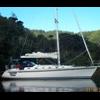-
Content Count
8,617 -
Joined
-
Last visited
-
Days Won
270
Content Type
Profiles
Media Demo
Forums
Gallery
Calendar
Store
Everything posted by Island Time
-
Here is a pic of how the system works...
-
Nope. There will be a heat exchanger between fridge and freezer. Not yet installed. I'll post a pic when it is, but there are 2 50mm dia tubes between fridge and freezer. There will be a SS plate/cover over them on freezer side, and on fridge side a temp controlled fan takes air from top of fridge, blows it across the plate in freezer, returns it to fridge. There is no air exchanged between fridge and freezer, as that causes frosting. Basically the fridge runs as a parasitical load from freezer. So both cabinets from the one condenser...
-
Its an Ozefridge. Its air cooled until the condenser reaches 38 deg, then it swaps to water (fresh water, borrowed then returned to the tank). Uses eutectic tanks for holdover. Once finished, I hope to be back to one run per day, about 30% of the time in the tropics, less here in NZ... Does not really use the water cooling in NZ, except sometimes in mid summer.
-
Current state... coming along slowly...
-
Oh, and what Brand or production boat? I can show you installs on Hanse, Jenneau, Bene and a few others...
-
The answer is "it depends". Best way would be to take a look, as makes and models of all devices are needed to answer that question. No decent marine electrician will install a system that does not comply with the current NZ regs -AS/NZS 3004 (and therefore meets Ewof stds). The main issue here is both Audio and Visual alarms before a batt disconnect. Entry level (one install I'm doing on 14th for example) will be approx $4k installed (using existing DC-DC), 314 A/hr fully compliant. Another I did recently was $14k, 942 A/hr, Dual alternator conversion etc....
-
Same. Also, why do they wait until a vessel has sunk? Takes lots more time and $$ then!
-
What would you like to know? I work out of GH, and have a few customers here with Lithium conversions. 2 more upcoming... feel free to call me if you wish. Matt Neptune's Gear Ltd 0221539176
-
The v60B (simrad version is RS40b) is a good unit, but does not have wifi. It's $1758 Incl GST. Its not supported by a Navman 550, which is why I suggested the NAIS500 and an MFD (Plotter, with wireless). NAIS with Splitter, GPS ant, and 7 inch Vulcan is about $2800. Its a bit less than the V60B and a MFD... Happy to Discuss with anyone interested. Matt 0221539176
-
Dont rely on Marine traffic at sea. It can be a long time behind (an hour or more) real time. A ship goes a long way in an hour!
-
OK. AIS transponders with screens or wifi are a bit pricey, especially if you want wifi as well. The digital yacht ait5000 doesn't have a screen, but is a transponder with wifi - its $2300 incl gst. Considering you could buy a B&G MFD AND a NAIS500 for about $2500, that might be a better option... that would give wifi via the mfd.. As BP says you don't NEED anything (even a yacht - people have crossed oceans in rowboats!)
-
shorthanded in a small boat a transponder is better than a radar reflector.... what are your instruments? (Other than the Navman?)
-
Its 5mm Acrylic. Bit more progress today with a test fit before side on fridge and top on both
-
The lifejack tether thing is interesting. I used to be involved in whitewater kayaking, and have training and experience in swiftwater rescues. There are special life jackets available for this. They include a harness and tether. The tether connects to the jacket above the waist at the BACK. This is because a front mounted tether will submerge you in fast water. A rear mounted tether brings you to the surface. The tether have a quick release at the front on a simple lever buckle. This system works very well, and many swiftwater rescue guys wear an inverted knife mounted on left shoulder...htt
-
So the cabinets are coming along. Next I have to figure out how to do the lids and seals. The old ones were hinged, but only sealed on 3 sides, not along hinged edge. Anyone got any clever ideas about how to make a lid that seals properly and hinges? Maybe I'm over tired, I can't think of a good way right now! And thanks to Tony (ynot on here) for the insulation!
-
Yeah, still a fair bit of the mahogany timber had to be removed - partly why I put it off so long! Tried to get it out in as few pieces as I could, as I intend to reuse it... The counter top had to be demolished, so a new one to come, of course that won't match the sink top exactly, nor the heads benchtops. I'm sure the Admiral will want those done as well so they match again...
-
Well, after 38 years, the fridge and freezer in Island Time is due for replacement. They are big (290ltrs), but the insulation is knackered. It now takes a lot of running to keep cold, and has greatly reduced hold over. Due to the time of year, and the lack of work at the moment, I've bitten the bullet. Below you can see removing the cabinet, how wet the insulation was, and how it looks,with the cabinet removed tonight ..
-
Nope, still missing apparently; Kerikeri Chronicles · Join Ross Watters · sptdooneSr7uiuuctag72317a1f4g39iita0ugg5h264g0170ai0mgia9180 · HARBOURMASTER’S OFFICE - URGENT NOTICE Police are seeking information on the whereabouts of Julie Butler, who is missing from Aotea/Great Barrier Island. The 55-year-old usually lives aboard her yacht the ‘Blazing Shadz’, moore
-
Mammoth undertaking!
-
Yes, I agree with that, however that's why I put in that link. Other (not LifePo4) lithium ion batts are generally not considered as safe as LiFePo4. Perhaps this link is better https://www.lithiumbatterytech.com/lifepo4-vs-li-ion-vs-li-po-battery-complete-guide/ and I've quoted some of it below... Composition of Cathode, Anode, and Electrolyte The cathode in a LiFePO4 battery is primarily made up of lithium iron phosphate (LiFePO4), which is known for its high thermal stability and safety compared to other materials like cobalt oxide used in traditional lithium-io
-
https://www.anker.com/blogs/others/lifepo4-vs-lithium-ion LiFePo4 is considerably safer than Lithium-ion... As tested by ABYC.. might see If I can find that report if I have time...
-
Id just like to re-iterate -the issue is that (IMO) Lithium Ion has no place on a yacht. LiFePo4 only!...
-
Personally I've NEVER seen a recreational vessel with a fire proof battery box... With LiFePo4, you are MUCH more likely to have an electrical fire at a high resistance connection or failed appliance than at the battery. Pretty hard to make the entire electrical system fireproof. IMO better to put the main battery switches somewhere easily accessible and/or have remote cut-off switches so you can easily shut down the power source. And decent extinguishers. I think a LiFePo4 battery fire is EXTEMELY unlikely, especially in a system that meets the standards for monitoring and auto shut
-
Yes And standards are NOT normally retrospective. The current NZ legal standard is the one I quoted above. If you are after a commercial vessel install, best to speak with your local MNZ electrical surveyor.



